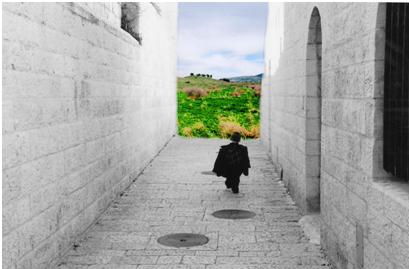.הליכה מסביב ירושלים
Today, our Israeli seminar included a walk around Jerusalem. My instructor, Paul Liptz, recommended that we record our sessions for ourselves (and to help write our journal entries that we will periodically turn in). Lucky for me, I have a perfect outlet!
We started off this morning with a brief conversation about the attack I wrote about briefly yesterday. Basically, Michael Marmur wanted to discuss the HUC notification practices with us since, fortunately, the events of two nights ago weren't so serious as to require significant processing.
Then, we went into our three Israel seminar groups. In Paul's we spent a few minutes introducing ourselves and sharing our previous Israel experiences. It was interesting to hear the different experiences that people had had with Israel - some very negative and some extremely positive. There were even some Canadian/American differences that might be based on a difference of perspective that was addressed later in the class.
Professor Liptz' class started with a brief discussion of the transition from "pre-modern" to "post-modern" in Christian Europe and transitioned into a conversation on the more European/Middle Eastern social structure of many cultural sub-groups forming the whole (as compared to the American model where sub-groups are generally de-emphasized in face of the universal whole). We discussed the multiple sub-groups in Israel within Jewish and Israeli Arab spheres. Distinctions can be drawn based on religion, time spent living in the country, politics, location, economics, class, etc. This obviously served only as an introduction to a much (MUCH) larger conversation that will be taking place over the course of the year.
Then, we hit the road. Professor Liptz gave us maps that detailed the expansion of Jerusalem and showed that, prior to 1917, Israel was mostly controlled by Christians - although Jews were the majority, they mostly kept to the relatively small area of the Jewish Quarter of the Old City. After the 1917 Bolshevik Revolution, however, many Jews began immigrating to Israel, and their emerging contact with the British began immediately. (The Balfour Declaration was signed in 1917, but the British didn't have a strong bureaucracy in place until 1920/1921.)
We walked to the King David Hotel, where we discussed the centrality of the British to the region as it progressed from Ottoman rule. Key to our conversation was the hostility between Jews who wanted to cooperate with the British (the Haganah and other groups, championed by David Ben Gurion) and those who felt that palpable declarations of strength were required to win sovereignty from the British (the Irgun and other groups, championed by Menachem Begin). A major break between the groups occurred when Begin insisted on carrying out the 1946 bombing of the King David Hotel while Ben Gurion opposed the action. Ninety-one people were killed, and this marked a low point in the outlook for Jewish independence and the closest Jews had come to civil war since the destruction of the Second Temple.
We didn't proceed along the timeline from that point (we're saving it for class) and instead moved to a different part of the city, near an old, unattended cemetery. There, Professor Liptz talked to us about the extraordinary complications involved in Jerusalem construction which include the requirement to maintain the outer walls of certain buildings (even if everything inside is torn down and rebuilt) and the inability to build over bones (so every contractor's nightmare is discovering human bones in her foundation). We also learned about the politics of land. As more Jews were moving to Jerusalem, some wealthy Muslims started buying land around the Old City to keep them geographically at bay. This policy resulted in Jewish settlements in various places outside the Old City that often tried to get as close as possible to the Old City.
However, a group of immigrants that distinctly did not want to be close to the Old City were the German Jews who no longer felt ... comfortable ... in Germany. They planted trees, built expensive houses, socialized with wealthy Arab Christians, and avoided the Old City at all times. They were "modern" and "civilized" and did all they could to bring the things they loved most about Berlin with them to Jerusalem. Today, the area where they lived is the neighborhood of Rechavia and is still fairly well-to-do.
Near Rechavia is Talbiyeh, which was prime real estate for wealthy Jews who were moving to Jerusalem. At the top of a hill, there's always a breeze in Talbiyeh. The houses are beautiful, and Golda Meir lived there while she was Prime Minister. Additionally, the Israeli President's house is located in Talbiyeh, as is a center affiliated with the philanthropic Bronfman family, adding to the splendor of the neighborhood.
We finished our tour in the German Colony, which was founded by Templars in the second half of the 19th century. These Christians built very solid houses, expecting to establish permanent residence to be passed through the generations. However, in 1939 or so, it was discovered that many of the residents supported the Nazi government in Germany. The British weren't too happy with Nazis living in their territory, so they were forcibly relocated to internment camps in Australia during World War II. As far as I know, they didn't return, and if they did, it generally wasn't to these houses, which are inhabited by "ordinary Israelis" today.
It was great to walk through familiar parts of Jerusalem and hear about the convoluted history that is entirely unapparent just by looking at the surface. I look forward to seeing how these interwoven narratives contribute to the genesis of the new Israeli society that I've landed in for the year. Should be fun.
Wednesday, September 24, 2008
Subscribe to:
Post Comments (Atom)

No comments:
Post a Comment